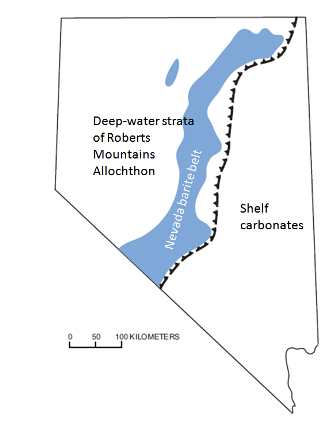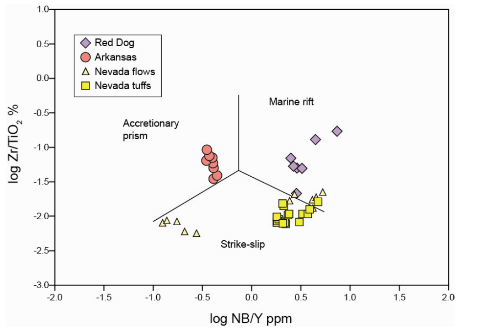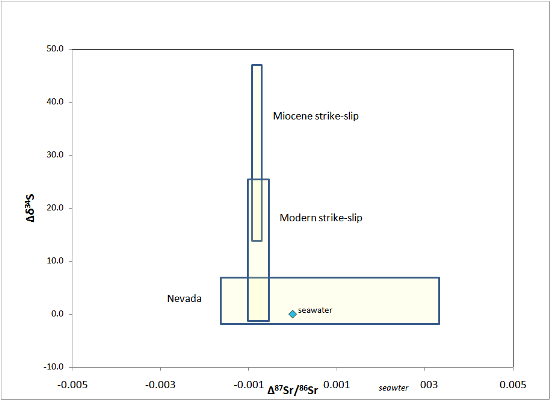Strike-slip cold seep barite - the Nevada barite belt

The Nevada barite district is the only domestic source of barite in the U.S. Significant deposits are hosted by both Ordovician and Devonian-age strata. Papke (1984) listed 120 bedded barite deposits in the state, 60 % of them in Ordovician host rocks and 40 % in Devonian, although 2/3 of production was from the Devonian-hosted deposits. Vein deposits also occur.
Mudstone Host
Lithologically, the barite-bearing sequence consists of laminated black shales, in packages a meter or so thick, interbedded with packages of black chert in beds 3 to 10 centimeters thick separated by black-shale partings. In the northern Shoshone Range, the black shales form discrete beds 1 to 3 meters thick, and beds of brown- weathering sandstone 10 to 100 cm thick occur in most sections. The section contains abundant phosphate nodules in addition to the radiolarian-rich cherts, indicating an important pelagic biological contribution to the deposition of the host rocks.
The barite beds crop out as lensoid bodies up to 15 m thick and as wide as 1.5 km. Their characteristic lenticular geometry is thought to reflect formation as mounds around hydrothermal vents and as gravity-flow deposits in seafloor swales downslope from submarine exhalative vents. Some Upper Devonian barite beds contain fossil remains such as brachiopods and hollow worm tubes analogous to faunas found around modern seafloor vents (Poole, 1988; Koski and Hein, 2003, fig. 2D), so some oxygen must have been present in the bottom water. The barite occurrences tend to be aligned, suggesting localization of the vents along faults on the seafloor. Some barite beds exhibit remobilization features including slumps, turbidites, and debris flows of unconsolidated Ba-rich sediment. These features indicate deposition of barite on the seafloor in a deep-water (below storm wave base), poorly-oxygenated basin, probably by mixing Ba from a hydrothermal source with SO4= from seawater.
However, Jewell and Stallard (1991) and Jewell (2000) have argued, based on high phosphorous and organic-carbon contents and low Fe and Mn in the host cherts, that the source of the Ba could be entirely biogenic. Murchey at al. (1987) proposed a hybrid model in which initial biological enrichment of Ba in muds beneath highly productive surface waters was later followed by remobilization of dispersed Ba during sulfate reduction and its expulsion onto the seafloor to make the bedded deposits.
Volcanic Rocks

The Sr isotopic discrimination proposed by Maynard et al. (1997) is ambiguous when applied to Nevada (see Isotopes). A good discrimination, however, is seen on the plot of resistate elements of volcanic rocks, shown below. There is a strong association of the Nevada host volcanics with the strike-slip tectonic category, which supports the California Borderland hypothesis of Koski and Hein (2003). Like the California deposits, the data span a relatively wide range along the Nb/Y axis, and in fact overlap the rift category slightly at the high Nb end.
Isotopes
The Nevada barites are similar to strike-slip settings in Sr isotopes, although with a wider spread. S isotopes are somewhat lighter when compared to modern barites or to Miocene deposits of Southern California. The closer approach to seawater S values in the Nevada deposits suggests that those systems were larger and faster-depositing than those in the California Borderland, which produce only small accumulations.

Ore Deposits Home |
Barite references |
Site Map |
|---|